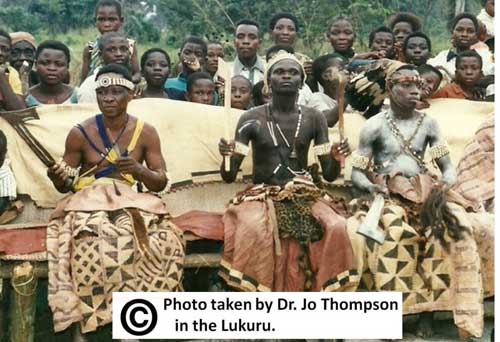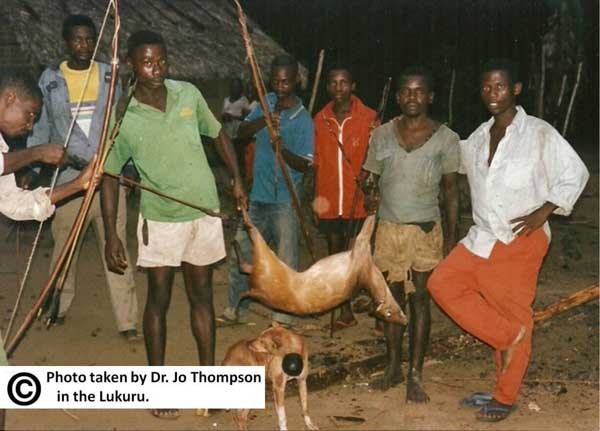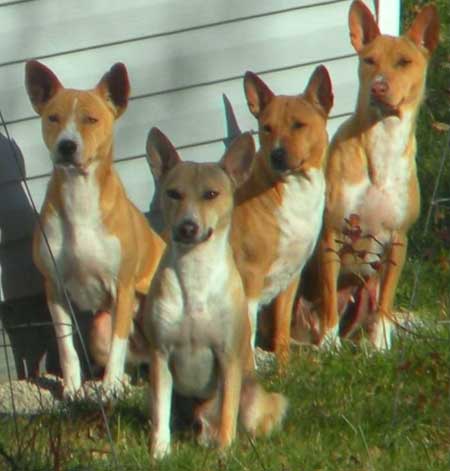Pages 14 & 15 <previous page >next page
This article and all associated photographs is the property of Dr. Jo Thompson & may not be reproduced in whole or in part without her express written consent.
The Lukuru Program - Part 3
The Lukuru Basenji Conservateurs
by Dr. Jo Thompson
"We are people to whom the past is forever speaking. We listen to it because we cannot help ourselves, for the past speaks to us with many voices." - from the "Creed of Living History" by Bruce Catton
Having the common purpose to manage the unique part of living history known as the Lukuru Basenjis, a dedicated, like-minded group of people combined their individual experiences, knowledge, talents, perspectives and ideas for a single purpose: the Lukuru Basenjis. The vision of the group is concentrated on the interests and management of the individual dogs imported from the Lukuru geographic region of central DRCongo and preservation of the Basenji breed at the source population. The group is known as the "Lukuru Basenji Conservateurs" (LBC). Congolese advisors suggested that we use the term "Conservateur" in our title to honor the Congolese heritage of our imports and also denote that our aim is preservation of the antiquity of the natural state of this ancient breed. We believe that the individual imports are a valuable asset to the welfare of the Basenji breed outside their homeland, but more importantly as individuals they are each a treasure to us all.
For thousands of years in the Congo Basin the Basenji developed with little human intervention but through natural selection and adaptation for their specific use in a particular environment. The role of humans involved how the dogs were utilized and the conditions set by the particular human culture and ethnicity (tribalism). Preservation of the Basenji breed at the source population is intimately intertwined with the preservation of the traditional forest people who share the same geography, local historical processes, and who construct the social and cultural context in which the Basenji type persists.
In the Lukuru, four indigenous ethnic groups represent the original human inhabitants on this land. For the original people, the land is associated with the world of their ancestors. This world is their source of wisdom and power. They believe that they belong to the soil and will return to it again; rooted to that piece of earth as their forefathers had been. They know that their ancestral land gave them birth and, when they die, they will be part of it once more.

Photo 1. The traditional village council adjudicates and dispenses authority.
The physical, climatic, and social landscape determines the way of life of the people. Serving the people who eked (then and now) out a life in the ancient equatorial primary-rainforest, the Basenjis adapted to these local circumstances and developed into a standardized geographically distinct breed. Where traditional forest-based ways of life have been maintained, the Basenjis have survived as a primitive breed to present day. They are an inseparable part of the way of life and the cultural traditions of the people. They are essentially a part of the legacy of the indigenous society. We believe it is important to save these populations of true aboriginal dogs within their original indigenous milieu.
The people, who know only traditional forest-based livelihoods, are dependent on hunting large-bodied mammals for survival. They are a proud hunting culture constructed around the desire for a meat-based diet. Thus, their lives in the ancient equatorial primary-rainforest require a specific arsenal of traditional hunting tools. The dogs are the property of the hunter; a part of the tool kit along with bows, arrows, spears, and nets made from local plant fibers. Forest meat is the primary source of proteins essential for household subsistence for these forest-dwelling people, different from the diets of the river people who subsist primarily by fishing and trading. Duikers (forest antelopes) are among those species most preferred by the forest hunters. It is working the net hunt for these large hoofed mammals in the equatorial primary rainforest where the Basenji is a specialist.

Photo 2. Typical scene of local people after hunt.
Since the Lukuru Basenjis are considered a part of the cultural and natural heritage of the indigenous people living in the geographic area of the source population, the desire to work for their preservation was shared by our group members. Comprised of Kevin Leimback, Therese Leimback, Karla Schreiber, Parry Tallmadge, and Jo Thompson, the LBC group works and communicates closely with each other as equals in our role as curators for all native stock imported from the Lukuru and as the managers of the breeding program. Our group goals are substantively broader than the welfare of the Basenji outside their native home and expanding the domestic Basenji gene pool. Ultimately we are concerned with maintaining, protecting, and preserving the uniquely isolated archetype native population of primitive Basenjis in the Lukuru. In the immediate timeframe, the imported Lukuru stock will be managed and tracked by the group. The group will control all records of health screening. Additionally, the progeny of the breeding program will be tracked over time. It is expected that this record will provide detailed information about the individual imports and their contribution to the breed outside their homeland origin.
In addition, the conservation effort at the source population is an ongoing work in progress. We feel that it is important to preserve this aboriginal landrace breed in their native environment by working for the preservation of the humans that accommodate them. Our principal focus continues to be the Iyaelima people who live inside the boundaries of a national park. They are locked in a time capsule where development and encroachment of outsiders cannot occur. Specifically, we are spearheading the only substantial initiative to ensure that the Iyaelima ethnic group has permanent legal status to remain on their ancestral land and maintain their traditional lifestyle. The Iyaelima are the original human inhabitants of the land. The Iyaelima people have occupied this land since the humans first migrated into this region. They identify themselves as being characterized by this territory. It is the land where their ancestors remain. It is the source of the Lukuru Basenjis.

Photo 3. The Lukuru imports (left to right) : Mopaya, Amisi, Lema, and MPale.
Currently, there are four imports from the Lukuru. Today we are concentrating on screening, testing and documenting the health of the four. At the time they were taken from the Congo, they all had the normal load of various intestinal worms, infected sores and scabs, infestation of mites, fleas, ticks, fly bites, fly larvae embedded under their skin, and other things that you just take for granted in the Congo. In particular, both Mopaya and MPale had pieces of ear-skin eaten away by severe fly bite wounds. Both Mopaya and MPale have some disfiguration of their ears from those wounds. MPale actually lost a huge hunk of her left ear tip when I bathed her in the Congo; it came off in my hand.
When we started doing the health screening and different wellness tests once they were in the states, we found that both Lema and MPale suffered from trauma-induced issues, evidence that their life circumstance in utero and for the first weeks of their lives were very harshly unforgiving.
Today, Lukuru na Liboso Mopaya is currently in the application process to be registered with the American Kennel Club (AKC) as Foundation Stock in the Basenjis Studbook. Her information can be viewed at http://www.basenji.org/NativeStock/Applicants/List2010.htm
In 2009 Lukuru Amisi was accepted by the Basenji Club of America Board and members as a native Basenji. He was registered by AKC as Foundation Stock in the Basenji Studbook. He will continue with health screening and will be available for stud to approved bitches in the 2010 season.
Lukuru MPale has been spayed but, as a full litter mate to Lukuru Lema, she will continue to be health screened and tracked.
Lukuru Lema is currently in the application process to be registered with the AKC as Foundation Stock in the Basenjis Studbook. We know that Lema and MPale were exposed to severe trauma in utero and during their early months of life. This was first confirmed during CERF testing when they were 4+ months old. As a result, we are closely monitoring Lema's eyes with an ERG (electroretinogram) every six months. Her most recent evaluation (November 2009) verified that Lema is clear for both Persistent Pupillary Membrane and Progressive Retinal Atrophy. In addition, her scotopic (night vision) and photopic (day vision) scores were well within normal range. Because of slight misalignment of her lower incisors, a specialist Veterinary Orthodontist also examined Lema. It is not possible to confirm whether these conditions are due to trauma related events during her development and bone growth or may be familial. If accepted for AKC registration, Lema will be bred only to dogs with normal occlusion. Her information can be viewed at http://www.basenji.org/NativeStock/Applicants/List2010.htm
“It would be a tragedy if dogs of such ancient lineage, which have preserved their identity through countless centuries, should now, through civilization, be lost for all time.” - from “The Barkless Dogs of Central Africa” by Veronica Tudor-Williams 1946